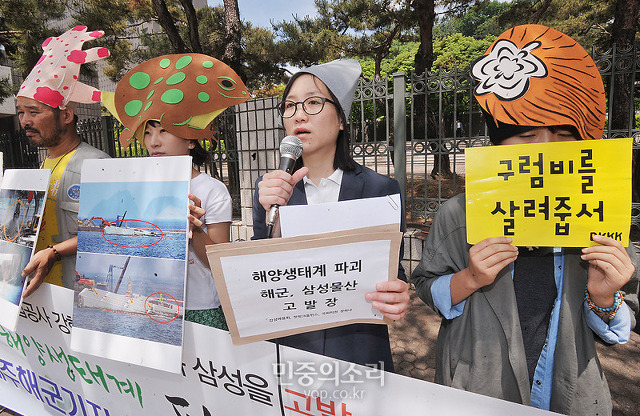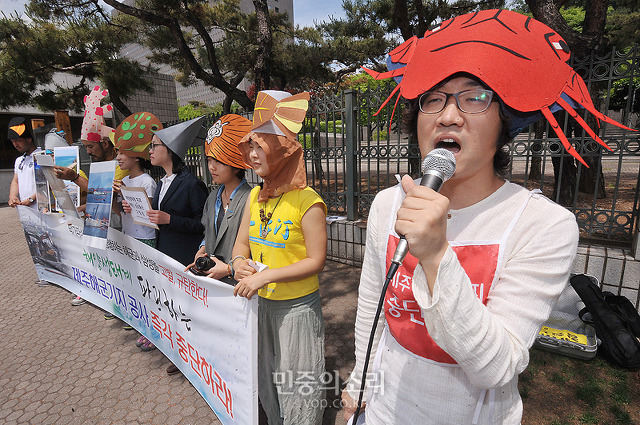In this month’s issue:
100,000 Books arrive in Gangjeong for the creative transformation to a “book village”, National Assembly inspections on the base, Solidarity from Italy and Western Europe, Gangjeong at the Busan WCC Assembly 2013, Trial updates, outrageous imprisonments, police disrupt prohibit catholic Eucharist and more!
Save Jeju Now
No War Base on the Island of Peace
Tag: environment
-
Oliver Stone Visits Jeju Island
(Fwd by Bruce K. Gagnon on Aug. 22. Re-blog from the article of Counterpunch, Aug. 23 to 25, 2013 and Hollywood Progressive, Aug. 26, 2013)
K. J. Noh, Oliver Stone and Bruce Gagnon were on KPFA radio in Berkeley, California on Aug. 22 talking about Jeju Island and the horrors of the Navy base. See here.
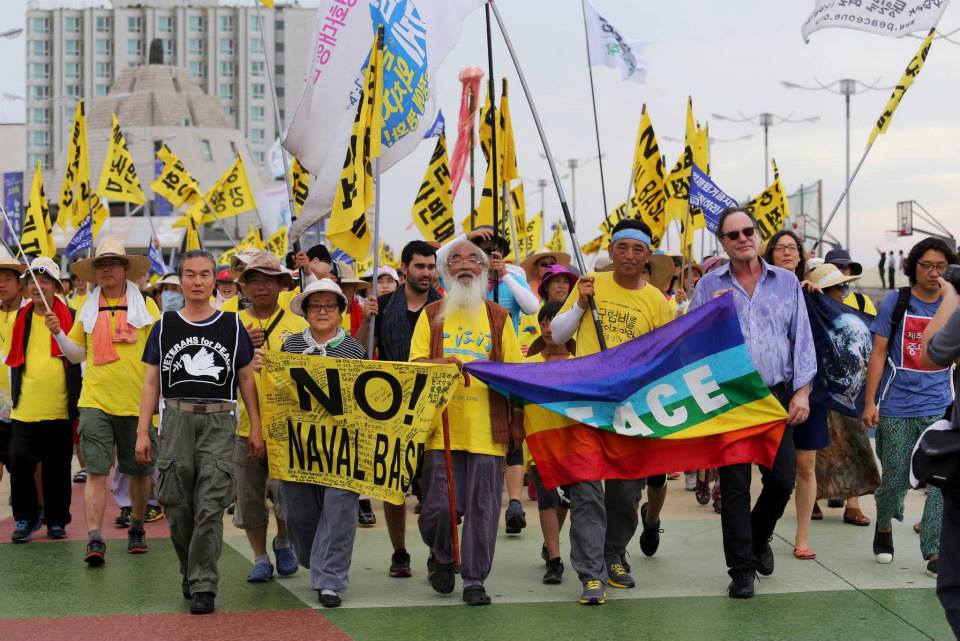
Oliver Stone marches with the leaders of the struggle on Aug. 3, 2013 (Photo by Lee Wooki) Oliver Stone Visits Jeju Island
By K. J. Noh
In 1986, a young American director, burst out on the screens with a raw, charged, kinetic film. Depicting a country on the verge of popular revolution, it documents the rightwing terror and massacres that are instigated, aided and abetted by the US government. Beginning as the chronicle of a gonzo journalist on his last moral legs, the film starts out disjointed, chaotic, hyper-kinetic; the unmoored, fragmented consciousness of a hedonic drifter. As the events unfurl towards greater and greater violence, the clarity and steadiness of the camera increase, its moral vision clearer and fiercer, carrying the viewer through a journey of political awakening even as the story hurtles inexorably towards heartbreak, tragedy, and loss.
The name of the director was Oliver Stone. The film was “Salvador”. Opened to dismissal, derision and poor distribution, it nonetheless garnered two Oscar nominations , and is now lauded as one of the most important films of the period, acknowledged to have influenced the political debate, if not the policy, around Central America at the time.
27 years later, Oliver Stone is discussing this film with the renowned Korean Film Critic Yang Yoon Mo. Professor Yang mentions Salvador, and the powerful effect it had on his generation during the violent, brutal military dictatorships of his era. “We loved it. It was a big inspiration to people all over the world. We obtained bootleg copies of it and watched it. It inspired a whole generation of young Korean film makers—for the courage and clarity of its vision. It was a model for us of what ethical and political cinema could be.” Stone smiles gently, and then reciprocates with his appreciation of current Korean Cinema—cinema that he himself may have had a hand in shaping—as he mentions “The President’s Last Bang”—a wry, understated morality tale about the assassination of the Dictator Park Chung Hee, during a dinner party-cum-orgy procured by his own intelligence services.
The rapport between two is warm and genuine and they talk as if they are old friends, old film buffs. It’s almost possible to forget for a moment that this is taking place inside a Korean Prison on Jeju Island, where Professor Yang has been sentenced to 18 months as a political prisoner, that he has been 70 days on a hunger strike, and that there are 6 of us crammed into a closet-sized visiting room: Oliver Stone, Father Moon, several activists, and an violent-looking police officer, whose every gesture and look intimates a furious desire to pound us into submission. On the other side, behind dual paned Plexiglas, the gentle Professor Yang is with another police officer, who is furiously transcribing every word that is exchanged.
It’s almost possible to forget that minutes before, we had been stripped of all cameras and recording equipment, had our ID’s confiscated and recorded, and had been escorted by half a dozen policemen to “have tea” with the chief of police, so he could “chat” with us. The police chief is warm and congenial, as only someone with absolute mastery of the rhetoric and machinery of power can be: Pontius Pilate, surrounded by his centurions, speaking softly to send the just the right mixture of benevolence and imminent threat. Out the window, to the left, we are surrounded by a panorama of verdant trees and hills. To the right, inches away, a squadron of blue suited, glaring police. It’s clear that there is more than one director in the room.
Professor Yang is being held in this jail for 18 months, along with dozens of other protestors, for the non-violent protest of a deep water Naval Base that is being constructed in Gang Jeong village on the Island of Jeju. He has been imprisoned 4 times.
****************************************************************
Jeju Island is a stunning subtropical island, 60 miles south of the Korean Peninsula, an ecological jewel that is home to UNESCO World Heritage sites, and biosphere reserves. World heritage sites are global treasures such as the Grand Canyon, Yellowstone Park, the Pyramids of Giza. Jeju has three of them. The shoreline of Gangjeong village, where the base is being built, is an absolute conservation area, made of soft coral, harboring many rare endangered species, and home to two thousand subsistence farmers and divers. The area called Gureombi is a site that is considered sacred to the villagers, a living, breathing landscape of tide pools, lava rock formations and stunning volcanic coastline irrigated with crystal clear springs:, the precious mineral kidneys of the island. Unfortunately, the Jeju base is also one of the centerpieces of Obama’s militaristic Pivot to Asia. Within easy striking distance—45 minutes by jet bomber, or 120 seconds as the missile flies–of Shanghai, Beijing, Tokyo, Taiwan, Vladivostok, it menaces all the major cities of East Asia. If we imagine the pacific table as a large family banquet, the military base is a loaded hair-trigger shotgun, and Jeju island is the rotating lazy susan platter in middle.
94% of the villagers are adamantly opposed to the construction. 140 National organizations, and 110 international organizations have called for its cessation. The Korean Parliament has demanded an investigation. The leaders of all the major religions in Korea have called for dialogue. The 5 opposition parties have challenged the legality of the construction. Yet construction has gone ahead, violating, subverting or ignoring every democratic process, every local, regional, national, international statute, charter and law. And so for 7 years, every single day, in one of the most disciplined non-violent struggles ever seen in the country, the villagers have been protesting the construction of this base with marches, prayers, petitions, art, masses, non-violent resistance . To date, 700 protestors have been arrested—including the largest mass arrest of Catholic Nuns in Korean History. Yang, along with other prominent intellectuals, civic and religious leaders, members of parliament, Buddhist nun, the Mayor of the village have all been “dragged like animals and beaten unconscious”, arrested, fined, sued, harassed by police, marines, and hired thugs; and received death threats. They have also been branded as Communists, opening them up to potential prosecution for Sedition under the draconian national security laws. It’s widely suspected Yang was singled out by the Korean National Intelligence Agency (the rebranded Korean CIA) in retaliation for drawing international attention to the issue. He is the longest serving prisoner to date.
****************************************************
Salvador is also an apt point of reference for Jeju: at the end of the war, Jeju itself experienced its own history akin to El Salvador, but on a scale—if such comparisons of human suffering are ever possible– that dwarfed the bloodbath in El Salvador: In El Salvador an estimated 75,000 were killed over 12 years, roughly 1-2% of the population, making it one of the bloodiest of the bloody, dirty wars in Central America. On the small island of Jeju, that number, or more, were killed in less than a year (10-30% of the population), making it the first, and bloodiest genocide of the post-war era, and the savage template for subsequent US interventions across the world.
The historical background is as follows: Korea had been a colony of Japan since 1910, suffering hideously under a brutal occupation. After the surrender of Japan in WWII, the US Military Government occupying South Korea was astonished to discover that there were thousands of functioning people’s collectives (worker’s committees)-forged from anti-colonial resistance– in the south, constituting a Defacto popular government, with strong nationalist and socialist leanings. In order to suppress this grassroots socialist government, the Korean People’s Republic,—American surveys show 80% of the population supported a socialist system—worker’s councils were outlawed, leaders imprisoned, a puppet dictator was rapidly installed, and the brutal apparatus of Japanese colonial rule was reconstituted in its entirety.
Jeju Island with its strong tradition of anti-colonial struggle was one of the strongholds of these indigenous collectives, leading it to be branded as a “red island” by the US Military Government. When popular protest against the division of the country, capitalist recolonization and the wholesale re-institution of the collaborator class and its police force became vocal, a scorched earth policy of genocidal proportions was unleashed. Using paramilitary death squads, strategic hamlets, free fire zones, mass rape, mass execution, torture, napalm, defoliation, entire villages were wiped out, 70-90% of all dwellings burned to the ground, and up to 80,000 massacred; these tactics were to foreshadow US policy across the rest of Korea, in South East Asia, Central and Latin America, Indonesia, Africa, and of course, El Salvador.
Members of Yang’s family were among the first killed in these massacres. For half a century in South Korea, it was a crime against National Security, punishable by imprisonment and torture, to breathe a word of this history. The island, a lush, beautiful subtropical paradise, with rich, volcanic soil, is strewn with unmarked mass graves, and haunted with unspeakable trauma. Those who survived these killing fields, fled in terror, some 40,000 or so. Those who remained were marked as subversives by family association, banned from civil employment, and driven into exile, poverty, suicide, madness. Even the massacres themselves were erased from history, leaving the survivors unable to mourn, grieve, or seek redress. After the slaughtered bodies were dumped into mass graves or caves, the facts vanished into an event horizon; even the memory of their obliteration was obliterated. Jeju Island, for all its beauty, is filled with ghosts—the unmourned dead, and the hushed, inconsolable pain of the survivors. In this context, a large portion of the population see the remilitarization of their Island—belatedly designated as an Island of Peace—as yet another desecration, the nightmarish continuation of an atrocity that has yet to end.
****************************
Oliver asks the Police Chief, about the conditions that prisoners like Yang are kept in: He asks whether they are able to exercise, read, receive and write letters. The Police chief, ever the congenial diplomat, answers, that he is extremely attentive to the health and well-being of his inmates, and that they are allowed all manner of comfort and recreation. He adds a comment about his concern about the hunger strike, and states with a worldly flourish, that “Esteemed Director Stone will find that the conditions of prisons in Korea are not that different from conditions in American prisons.” “Esteemed Director Stone”, does not seem assured, and without missing a beat, points out that “the conditions of US prisons are, according to the United Nations Rapporteur on Human Rights, some of the worst in the world. The systematic and routine use of prolonged isolation has been found tantamount to torture.” The police chief accedes than that perhaps there are differences, and with the hair-splitting skills of a trained bureaucrat, mentions that Korean inmates sleep on traditionally heated floors, whereas American prisoners must sleep on beds. There’s no easy conversion scale to weigh the tradition of intimidation, bastinado and torture of a Korean prison against the isolation, violence, racism of the American penal system. A beautiful police woman, impeccably coiffed, and immaculately made up,–a police geisha, if you will– passes around spring water in exquisite cut crystal glasses, with the terrifying precision of an assassin, moving, as if on cut-steel grooves. There is no need for ice. We gulp our water, thank the police chief, and Officer smash-your-face-in-if-you-so-much-as-blink-wrong then escorts us, with 5 other officers, down to the visiting rooms to meet with Professor Yang.
*************************
90 minutes earlier, Oliver had flown directly in from Barcelona, after 7 days non-stop night shooting of a commercial, and had landed in Jeju, exhausted and bleary eyed. “I don’t usually do commercials”, he says, “but this was soccer—it encourages people to exercise, get healthy, so I’m okay with this”. Oliver looks to be needing a bit of exercise himself: 10 time zones and 20 hours of non-stop flying and transit have left him exhausted and drained. He has wiped clear his schedule, and made a huge sacrifice to travel to Jeju, but as his exit from customs is delayed, the greeting team of local activists at the airport has become anxious that he will simply be denied entry into the country. The Korean government has already denied entry to several international peace activists at the airport—most notably Elliot Adams, Tarak Kauff and Mike Hastie from Veterans for Peace, and it is not inconceivable that they would do the same for any perceived rabble-rouser. Alternatively, they are not above a little “rough play”, and for the Korean Authorities, for whom a beatdown is just a friendly way of getting acquainted, a sound drubbing could be spun as just an over eager welcome or a misunderstood expression of solicitude. The burly men in suits and earpieces tailing the greeting team make this not an unlikely possibility. Finally, when Oliver is released from transit purgatory, all of us breathe a sigh of relief, although for some reason his luggage has gone AWOL. Over the next 48 hours, the luggage will be repeatedly located but yet somehow unrecoverable, claim documents will not be filed, others improvised, leading activists to wonder if this is part of the harassment: :disrupt morale by disrupting logistics, separate the “enemy” from their materiel—in this case, Oliver’s clothes, toiletries, medicines, and his colorfully subversive collection of bandannas.
After a frantic, truncated 30 minute lunch at a local restaurant—there are no power lunches in rural Korea, only hurried ones—the team belatedly shuttles to the prison, where Professor Yang is waiting. We submit to the mandarin ceremonies of power which permit us the short visit to professor Yang. Then, as Oliver and the professor are talking shop, Oliver mentions his new series, “The Untold History of the US”. As a director, he is known for his prolific output, sometimes making two or more films in a single year. “The Untold History”, however, is a 5 year labor of love, a meticulously researched ten hour documentary (and 700 page companion volume), unmasking and chronicling of the rise of US Imperialism. Howard Zinn’s “A People’s History of the United States” is most often mentioned in the same breath, but the other great chronicle of imperialism and its excess–Thucydides’ Peloponnesian War, is also an apt comparison: “The cause of all these evils was the lust for power, arising from greed and ambition, and from these passions, proceeded the violence”. Professor Yang seems intrigued, and although he has been incarcerated too long to have heard of it, he promises that he will try to find a way to see it. Oliver expresses his concerns for his well being, and inquires as to the depth of his support among other artists. Then all too quickly, visiting time is over, and we are reduced to silent gestures of good will and hope across the plexiglass. Professor Yang touches his palm to the glass, Oliver touches it, and then he slowly bows to each of the visiting team, hands together in traditional blessing. Professor Yang seems to have been deeply moved by the visit, but for us, it’s hard to avoid the sense of abandoning a comrade in prison. We stop as we are exiting the prison to do a quick interview with a wire agency, and Oliver fiercely denounces the detention of Professor Yang. “The courage of Professor Yang inspires me” he states, with fire in his voice. “I believe without a doubt that he is a prisoner of conscience and I call for him to bereleased immediately. I deplore the militarization of Jeju Island. I deplore the building of the base”. There is passion and heart in his voice. He will reprise this theme many times over the next few days, but like the other stories about Jeju, these statements will pass largely unreported in the mainstream press.
********************************************
Nothing in Korea happens in half measures, and the heat is no exception. The Jeju heat is swelteringly close to 100 F, the humidity is in the 80’s and although there is a march for peace against the military base that is happening—an epic two day march that will circle all the way around the island, then meet up in the north and come together for a mass rally at a civic plaza, followed on the next day, by a human chain around the base–we wonder if after the harassment, delays, power plays, exhaustion, the blast furnace of summer heat is too much. We ask Oliver if he is up to joining the march, as planned.
Oliver is still resolute. “Let’s do it” he says.
The following day, Koh Gil-Jun, a key protest organizer and artist–one of the key visionaries of the museum on the Jeju Massacre–will fall to the ground during the march, vomiting, paralyzed; done in from heat, stress, exhaustion, harassment, pain. He will be taken to emergency and diagnosed with a hemorrhaged vessel in his brain. But no one seems to be measuring risk against commitment.
“Haegun giji, gyolsa bandae!”
We arrive at the march—an ocean of yellow shirts and banners, youth, children, men and women, internationals—and a huge roar goes up, the tide of people surges and vibrates with energy. If, as it has been said, the true spiritual quest is not upward, or even inward, but forward, to march forward, surely this is one of its greater manifestations.
“Haegun giji, gyolsa bandae!”
A thousand banners flutter in the wind, and the crowd is abuzz with excitement and passion. Chants thunder through the streets, like an unstoppable heartbeat. Like the huge people’s marches that toppled the previous dictatorship, the winds of history, the breath of solidarity, the tide of inevitability, seem to propel the marchers upwards, onwards, forwards.
“Haegun giji, gyolsa bandae!”
Every dimension of human aspiration is present and alive.
Drenched in sweat, Oliver puts on a yellow T-shirt on top of his sweat-soaked shirt, and is invited to join the march at the front. He modestly declines to walk “point”, and falls into the ranks. Fabled director, Hollywood icon, decorated war veteran, becomes just another marcher in a sea of protestors, a forest of banners, marching, this time, against the Imperium.
“Haegun giji, gyolsa bandae!”
“Oppose to the Death, this Naval Base”
*******************************
.“How do we stop this thing? How do we stop it? We have to stop this thing.” He asks, as we return later to his lodgings. We tell him that it already has stopped, –temporarily—construction that has been ongoing nonstop, 24 hour a day, Christmas, New Years, holidays, has suddenly tapered off, and the site is eerily silent, except for the occasional pile driver. “It’s gone silent in your honor”, we joke. “You should move here permanently”.
Oliver looks out at the coast line from the balcony of his modest B & B. From there, what was one of the most stunning vistas on the coast, you can see a shoreline littered with rubble, construction cranes, bull dozers and concrete jacks.
Earlier in the day, passing the lego-block apartment complexes that were sprouting near the main city, he had jokingly inquired if they were Soviet-inspired. “This is as cheesy as anything Donald Trump would build. Donald Trump would love it here. How does a country with such good film makers have such bad architects?” He had quipped.
But looking out over the construction, no one feels like joking.
It’s not just narcissistic bad taste.
It looks evil.
**************************
Afterwards, we head out to the docks, to take a boat tour of the coastline. Mindful of his reputation and activism, Korean news media has largely honored his visit by coordinated and conspicuous neglect, but Oliver has had the foresight to pull in a Japanese news crew. A camera crew from NHK meets us at the docks, and we get onto the boats, and start our own tour of the coast line. Out in the water, with the cool breezes, the heat abates, and it’s hard not to get a sense of the enormity of it all, the power, the endless beauty, the endless generosity and abundance of this area. The pacific Islanders have a term, Moana Nui, which sees all the pacific peoples living in a harmonious web of mutual co-existence and nourishment, connected by the benevolent ocean. Connect all, so we may all live. There’s enough for all of us: ocean, space, energy, love.
It’s hard to reconcile this with the realpolitik that is gridding off this area as a deadly chess game: control the center of the game board–Jeju Island–the king pawn/queen pawn squares, dominate the vectors and channels of lethal force, subjugate all enemies: Occupy so we may dominate and kill.
The gentle swaying and cool breezes allow us to wash off some of the day’s earlier struggles, and we find the tour both relaxing and exhilarating. The ocean is a deep, sparkling cobalt, and with its gentle billows and power, we feel again the enchanting power and beauty of the water and the island.
On the boat as our tour guide, is a Jeju local, a shaman, meditation teacher, and also, incidentally, the founder of the first and only battered woman’s shelter on the island. “Domestic violence is inseparable from State violence” she tells me. “Militarism and military violence filter down into the smallest recesses of family life. We can’t struggle against domestic violence without challenging this base.”
She tells us about the origin myths of the island, the goddess resting her head at the peak of Mt. Halla, the volcanic peak of the Island, with her feet pointing up to become the island. The creation myths of Jeju island are all goddess myths, what powers lie within and around this island are nourished and channelled from the energies of the feminine.
The feminine is most clearly represented by the Haenyo, the legendary women divers of Jeju Island. The shaman’s mother was such a Haenyo. Fable has it that some travelled to the Japanese Isles, millennia ago, taught the Ama diver women of Japan and then spread the skill spread across the pacific; whether this is true, is unconfirmable, but what’s clear is that this is one of the few places on the world where breath-holding subsistence divers still exist. If the Haenyo have survived to this day, it is clearly because these women are a force of nature: they start diving in childhood, and continue diving into their 80’s and 90’s. They have the courage, endurance, and diving skills to make sissy boys of the Navy Seals’ Underwater Demolition Teams, and during the 1930’s, they spearheaded the resistance to the Japanese Military Occupation on the island. They spend hours in the water, three minutes with each dive, through all seasons, surrendering their lives to the ocean. Their hemp or twilled cotton shirts have been replaced by modern wetsuits, but that is the only concession that they have made to technology. They steadfastly refuse to use scuba gear, or even snorkels, relying on traditional practices of breath control, prayer, and meditation, both as part of tradition, but also with the understanding that stripping the sea bed with technology is pointless stupidity. Their lifestyle is profoundly spiritual and ecological, and it is dying out in the area. The base construction will be the death blow.
Centered around the economy of the Haenyo, Jeju island has, for centuries, been a traditional matriarchal society. “No thieves, no beggars, no gates”, was a phrase commonly used to describe the society of Jeju island, cooperative, communal, matrifocal, an indigenous form of socialism that led itself naturally to the grassroots workers’ councils that flourished after the liberation from the Japanese. These worker’s councils were the basis of the “red island” designation by the US Military Government, and were the trigger for the genocide. Bases will finish off what death squads, napalm, free-fire zones, and killing fields could not. If and when the base is completed, the traditions of generations of powerful women will be replaced with bar girls, prostitutes and housemaids. A young girl who would have learned from her grandmother to read the tides, dive to a hundred feet with only the air in her lungs, and talk to the spirits of the ocean to face down death, will be servicing GI’s on her knees in back alleys. Cultural Genocide, if the term has any meaning, seems appropriate here.
Basalt Columns appear on the Island that we are passing. This is Beom Seom, “Tiger Island”, a Unesco Reserve, and at close range, you can see the entire island is formed from hexagonal basalt columns, like a dark, chiseled, striated jewel in the ocean. The top of the high cliffs is covered with pine trees, and there are wave-carved tunnels and archways around the island, an exalted, mystical architecture. Whether you believe the myth of the goddess’s feet poking out of the dark sea or some other supernatural explanation, you know that you are at the conjunction of extraordinary forces of nature. Underneath the billowing ocean, there is soft coral, and in front of us, the volcanic peak of Mt Halla, and all around us, the breeze and endless ocean.
Turning the corner of the island, we witness full on the devastation of the base construction.
We stop the boat.
From the ocean, we can see the entire scale of the violation. It is monstrous.
“F***” Stone blurts out. .
Do not touch a single pebble, a twig, a flower. All of it is sacred, the protestors have been shouting for years.
7 story, 10,000 ton, steel-bladed caissons, have been sunk into the soft coral below, exposing themselves above the waterline like the bared fangs of a mad predator. Construction has blasted, pulverized, and befouled the sacred Gureombi, the living kidneys of the island, paved it over with concrete, leaving it looking like a massive latrine. Pile drivers, bull dozers, cranes, high explosives have gashed the womb of the Goddess of Mt. Halla, leaving concrete and steel maggots writhing out of its innards, and bleeding dark silt and slurry into the pristine ocean.
Around the crime scene, a sanitary cordon of buoys and construction curtains.
It is the scene of a heinous rape-murder.
Oliver gets up on the edge of the boat. Part lecture, part possession, part jeremiad, he points to the shoreline and launches into a full blown soliloquy.
“This base will host US destroyers, aircraft carriers, Aegis missile batteries, nuclear submarines. It’s part of Obama’s pacific pivot, a chain of offensive bases from Myamar, Phillipines, Thailand, Korea, Okinawa, a necklace of bases to choke off the pacific. It’s being put in place to threaten China. Even as we speak, war materiel is being shifted from Iraq, Afghanistan to the pacific”.
“We have to stop this. All this is leading up to a war, and I’ve seen war in Asia.” His voice trembles. “I do not want another war here. I’ve seen war in Asia, and we cannot have another war here. We have to stop this thing”.
He turns to the Shaman, invites her to put a hex on the base, to invoke Gods higher than those of empire, profit and militarism. .
Oliver then gestures himself, hurling passion, heart, grief, onto the shoreline.
We all scatter our prayers, curses, tears, to the waves and the setting sun.
Everyone is silent, as we head back to the shore.
“It is a given that those who would struggle for peace, must first know the meaning of devastation”.
– By K. J. Noh who is a long-time activist and member of Veterans For Peace
Global Network Against Weapons & Nuclear Power in Space
PO Box 652
Brunswick, ME 04011
(207) 443-9502
globalnet@mindspring.com
www.space4peace.org
http://space4peace.blogspot.com/ (blog)
-
3rd Jeju DMZ Peace Island Meeting to be Held in Moseulpo

Korean banner for the 3rd meeting. Tomorrow, August 15, 2013, the 3rd meeting of the movement to demilitarize Jeju “Jeju, the Demilitarized Peace Island” will meet. This meeting open to everyone will take place from 10 a.m. to 3 p.m. in Moseulpo, on the southwest cost of Jeju.
Moseulpo is an important place in the history of military and anti-militarist struggles on Jeju. During the Japanese colonization, the residents were forced to large caves out of the coastal cliffs of Mt. Songak to store torpedos to be used for attacks on allied forces in WW2, a part of Japans broader massive military build up of Jeju in anticipation of a stand off that fortunately never happened. Nearby is the abandoned Alddreu Airfield, also set up by the Japanese military for bombing China.

Caves along the cliff face of Mt. Songak. Later during 4.3 and Korean War, Moseulpo, like most of Jeju was also the site to several massacres including the Massacre at Seotal Oreum. In 1950, The Moseulpo Police had arbitrarily detained 344 people in the police station, a fishing storage, and a potato storage. 211 of the detained were eventually slaughtered without any legal process and secretly buried. 20 people were killed on July 16 and 193 on August 20. 41 other people went missing.
Later from 1987-1989, the Korean government attempted to build an air-force base on Mt. Songak, but strong local resistance won after a two year struggle and the plans were scrapped. However, the Korean Ministry of National Defense still owns land in the area and recently there was has been rumors that they again plan to build an airfare base there, perhaps on part of the old Alddreu Airfield (part of which has been declared a national heritage site). Meanwhile, the ROK MND has a small radar base in Moseulpo, formerly the U.S. owned Camp McNabb (for 53 years until it was taken over by Korean in 2005.

Moseulpo Radar Base, formerly U.S. Camp McNabb. In light of this history of oppression and resistance, Moseulpo is a key location for the movement to demilitarize Jeju.
Peace loving people from across Jeju and Korea will come together to tour the historical sites, hear about the successful struggle against the air-force base and discuss and plan the demilitarization of Jeju. Join us!
Contact gangjeongintl@gmail.com for for details.
-
UNESCO totally cheated by Jeju Island Government
Related links: [May 27 to 30] A Renewal of the UNESCO Biosphere Reserve Status? The Jeju Sea is being killed now.
Navy and companies’ illegal dismantling of damaged caissons on the sea
(Source: Jeju Internet News, May 29, 2013/ Original source: Gangjeong Village Association)
1. Maintenance of UNESCO Biosphere Reserve despite massacre of nature?/ People’s letter to the UNESCO
Despite great mass killing of UNESCO sea creatures in the Gangjeong Sea, Jeju, it is reported that the UNESCO International Coordinating Council of the Man and the Biosphere program (MAB) adopted the report by the Jeju Island government in its evaluation on May 28, 2013. The evaluation is held every 10 year. The Jeju Island became to continue to hold the title of the UNESCO triple-crowned: The Biosphere Reserve, World Natural Heritage and Geology Park. Please see the very related and important post regarding the matter of the UNESCO renewal , here.
The Jeju Island was designated as the Biosphere Reserve in Dec. 2012. The total designation area is 30.94㎢, which is about 45% of the whole area of the Jeju Island, It includes the Halla National Park, Youngcheon (Young Stream), Hyodoncheon (Hyodon Stream), Moonseom (Moon Island), Beomseom (Beom/ Tiger Island), Seopseom (Seop Island) that were designated as the CORE Biosphere Reserves in 2012. (See the same article of the Jeju Internet News linked above)
The status of the UNESCO Biosphere Reserve in the Jeju Island. The scarlet areas and spots indicate the core zones of the Biosphere Reserve: Mt. Halla, Beom, Moon and Seop Islands. The blue areas are buffer zones while the pale blue areas are transition areas. (source: Jeju Internet News, May 29, 2013)
The National Network of Korean Civil Society for Opposing to the Naval Base in Jeju Island has sent a letter to the UNESCO MAB secretariat as of May 29, to request the UNESCO ‘objective reviews on the Jeju Biosphere Reserve,’ concerning about the ‘destruction and pollution of the Jeju Biosphere Reserve in relation to the Jeju Naval Base construction.’ Please see the letter in English in the site (Please scroll down mouse until you see the English part).
In its letter, it first raised on the matter of ‘inconsistent maps of the Biosphere Reserve Buffer Zone’ around the core Biosphere Reserve of the Beom Island (Tiger Island):
‘Inconsistent maps of the Biosphere Reserve buffer zone brings confusions and raises doubts on the Government’s performance on monitoring the management and preservation of the entire Jeju Biosphere Reserve.” (See the letter for details)
It also made clear that the ‘sea route of the Jeju Naval Base would cut through the buffer zone’: ‘In the last World Conservation Congress held in September 2012, the Government insisted that the Jeju Naval Base construction does not violate the Biosphere Reserve. However, in any of above mentioned three maps, the sea route of the Jeju Naval Base would cut through the buffer zone, which would bring negative impacts on the Biosphere Reserve. The Government did not mention about these concerns in its Periodic Report submitted in September 2012.’
Thirdly, it raised on the matters of ‘pollution and damages of adjacent waters by the Jeju naval base construction,’ with the examples of unreliable silt-protectors and mass-killing dismantling works of damaged caissons on the sea.
Despite the letter, according to the the Jeju Island government who stated on May 29 , “the UNESCO MAB-ICC made an overall evaluation that ‘the Jeju Island is faithfully carrying out the Biosphere Reserve network rules and regulations,’ according to its advisory committee evaluation result. The MAB-ICC adopted the periodic reviews from the six regions of Canada, Germany, India, Paraguai, Mexico, and Jeju Island, among 55 regions, without special demand items. It adopted periodic reviews from the other regions with recommendation and demand items.” the same article reads. (See the article)
According to the article, ‘the Jeju Island government delivered that it included the physical character of the Island’s Biosphere Reserve; types of creatures’ habitats; activities within the Biosphere Reserve; activities on study, monitoring; education & training and public relation; management, policy, budget on its biosphere reserve.’ It also added that it ‘introduced Gotjawal, Oreums, inner land wetlands, and soft coral habitats as the habitats of special concern, while introducing stone culture and sea-diving women’ lives as its traditional culture.’
Did they ever report on the current on-going destruction and killing of UNESCO Gangjeong Sea by the naval base construction(destruction)? Probably NONE but with lots of cheats ! The UNESCO is dammed to be cheated by the Jeju Island and ROK governments. You may see the ROK government document to the MAB-ICC, here, which conceals many serious matters of ROK government’s environmental destruction in the UNESCO Biosphere Reserve, especially in the Jeju.
2. People file for a lawsuit against the navy and Samsung
On May 31, the ROK Day of Sea, some groups such as the Office of Jang Hana, National Assembly woman, Hot Pink Dolphins, and the Gangjeong Village Association filed for a lawsuit accusing the ROK navy, Samsung and Daelim, especially in relation to the navy and companies’ massacre of sea creatures with their thoughtless dismantling works of damaged 6 caissons, which started on May 5, this year, the Children Day in Korea. (See the accusation document in Korean, here).
The groups along with the members of the Seoul and Gyunggi branches of ‘Gangjeong Friends’ also had a press conference in front of the Seoul Central District Prosecutors’ Office on the same day.
Jang Hana, National Assembly woman talking and holding accusation document against the navy and corporations such as Samsung C & T, during the press conference on May 31. People wore the hand-made hats of endangered species in Gangjeong by the naval base construction(destruction)
Jo Yak Gol, member of Hot Pink Dolphins and a peace keeper of Gangjeong speaks during the conference on May 31. (Source/ Original Source: Voice of People, May 31, 2013)
According to Jang Hana, National Assembly woman: “The navy’s behavior of contaminating the sea ecology system in the Gangjeong Sea, by its dismantling process of damaged caissons underwater, bringing the very poisonous cement powders and concrete lumps in the sea is in violation of item 2 of article 22 of the maritime environment management.
The item 2 of the article 22 of the maritime environment management defines that “nobody should leak contaminating material that occurs in the maritime space such as maritime facility, beach resort, and mouth zone.” The punishment for the violation of it is up to two years’ imprisonment or up to 20 million won fine.
The people also reminded that when the World Conservation Congress was held in Jeju, 2012, there was a controversy of environmental destruction on the damaged caissons by typhoons. At the time, Captain Yoon Seok-Hwan stated in the press conference, that the navy plans to “float damaged caissons and then dismantle and dispose those ON THE LAND or dispose those in the ways not badly affecting environment. We will NEVER use the way such as underwater blast.” (See a Korean article, here) .
Go Gwon-Il, Village chairman of the Stop the Naval Base Project speaks during the press conference on May 31. The banner reads, ‘Immediately stop the Jeju naval base construction (destruction) that destroys maritime ecology system. ‘(Source/ Original source: Newsis, May 31, 2013)
However, that promise has never been kept. The navy is openly dismantling those caissons ON THE SEA, carelessly blowing out poisonous cement powders and lumps into the sea. Its disastrous result could be seen on the SOS teams’ May 15 video. “Even though the navy and Samsung say that they would dredge the cement on the sea bottom, there is really no way to dredge all the chopped-up parts of cement because those powders are spreading far into the sea by the strong currents of the Gangjeong Sea. It is already illegal to throw down concrete cement, poisonous waste, into the sea.” (from people’s accusation document)
3. Three recent important videos on the navy’s destruction of Gangjeong sea
(1) The navy and companies’ illegal dismantling of damaged caissons on the sea
It is a vivid scene of navy’s illegal dismantling of damaged caissons on the sea, which started on May 5. (Video by Moetppuri Park, edit by Ryu Dong-Kyun)
Seven caissons were destroyed by the typhoons such as Bolaven on Aug. 29, 2012. The whole production costs of those caissons are 35 billion won. The ROK Ministry of Construction and Traffic has concluded in 1998 that the caisson construction method is impossible in the southern part of Jeju, after the result of a year’s investigation. It is because of severe typhoons and currents to the total destruction of harbors in the Seogwipo area, the southern part of Jeju. (See the recent Korean article, here). Especially, the Gangjeong village is of a protruded out geography in its coast. The villagers have warned the navy numerous times that the village geography itself is impossible for any huge harbor, not to mention naval base. Despite that, the navy has enforced the construction (destruction). It is only forthe profits of big corporations such as Samsung.
(2) The UNESCO Gangjeong Sea being killed by the naval base construction (destruction)
(Video by Save Our Sea team on May 15, 2013)
‘While heavy metal-poisonous materials such as leaking earth and sands, concrete lumps and cement powders are injected into the sea as they are by the illegal naval base construction(destruction), the silt protectors never properly work because of unreliable installation and restoration of their damaged status… The Gangjeong Sea where the endangered species such as the Indo-Pacific bottle nose dolphins, red-feet crabs, soft corals have been playing is being killed. There hardly is no trace of living creatures in the bottom of the sea. Only sediment materials can be touched. The damage on the fisheries by the illegal naval base construction (destruction) is extended into Beophwan and Wolpyong, nearby Gangjeong’ (SOS. Source)
You may painfully compare the above video with the below which was taken in 2009, before the destruction of sea by the naval base construction.
(3) Illegal quarrying, transportation, and reclamation of sand and stones.
(Video by Kim Bok-Chul, edit and arrangement by Dungree(Park Sung-Soo)
The Jeju naval base project is already infamously illegal in the sense of dual MOU, violation of EIA, violation of law on the cultural treasure, layout flaw, manipulated fake simulation. It was disclosed by a construction worker last October that the Samsung C & T is building unreliable caissons, using the reinforce rods under-standard, which results in easy destruction of caissons by typhoons.
Not only that. The video discloses the illegal quarrying, transportation and land-filling of sand-stones by the companies.
On Jan. 31, this year, a peace activist, Mr. Kim Bok-Chul traced a truck from the Hwasoon port and Gangjeong and found that the stone-quarrying site located in the Mooreung-ri, Daejung-eup, Seogwipo City is illegal. Given the record, it can be estimated that tens of thousands of illegal sands and stones have been transported for 40 days around Jan. 31. Those illegal stones would never properly work in the basic construction of the base.
It has been also known that there are about nine transportation companies of which trucks commonly violate legal speed, freight amount, central line and traffic signs.
Putting sands and stones in the sea is also done in violation of the EIA. The silt-protectors have never properly functioned but rather contributed to the destruction of environment.
The navy and company should stop destruction of nature with illegal methods which are only for reduction of construction costs. The sea is of the soft coral habitats, which are ROK natural memorial NO. 442, as well as the UNESCO Biosphere Reserve.
While the Seogwipo Coast Guard is investigating on the illegality of sand and stones, the Seogwipo City and Seogwipo Police should also thorough examine the illegality of construction (destruction) rather than oppressing protesting people in violation of their human rights.
-
The Island government’s shameful remarks and moves after the 2012 WCC Jeju
1. Island government attributes the cause of failure in invitation of the UN CBD COP to people’s WCC protest
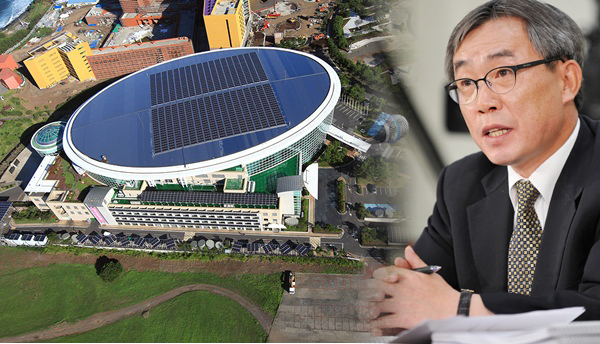
Image by Jeju Sori, May 2, 2013/ Kim Sun-Woo, vice-governor of Environment and Economy, Jeju Island. Some representing Jeju internet media criticize the Jeju Island government to point out the protesters opposing the Jeju naval base project as the cause of its failure to invite the UN CBD COP 12 (UN Convention on Biological Diversity, 12th Conference of the Parties). For reference, the COP 11 was held in Hyderabad, India, from 8 to 19 October 2012.
It was April 30 that the ROK Ministry of Environment decided the venue of the UNCBD COP12 in Pyeongchang, Gangwon province.
The Jeju media reports on May 2 that Kim Sun-Woo, Vice-governor of Environment and Economy, talked about the things during the review process on the location of COP 12 in the meeting with the news reporters accredited to the Island government on the day.
According to Jeju Sori,
Vice-governor Kim introduced an episode saying that, “one of the judges raised an issue on a performance that the opposing groups against the Jeju naval base project carried out during the WCC. It was the most embarrassing inquiry to answer during the examination process.”
He was pointing out the performance in which each activist did not move lying inside the venue of the Convention Center where the WCC was held [from Sept. 6 to 15].
However, the Jeju Sori criticized his remarks:
‘His is in fact merely an excuse. The Island governnment started its activities on the invitation of COP 12 this year. It has been less than 4 months.
Not only its start was very late but it has not gathered Island people’s collective opinions on it. The Jeju Island government has also confessed that “we could not afford it because of the WCC.”
The remarks by the Vice Governor Kim means he was unreasonably venting his wrath to the Gangjeong villagers who are suffering from the naval base project for seven years.’
Media Jeju also wrote that it feels the shady Jeju Island government shameful to attribute its failure on the invitation of the COP 12 to the protesters.
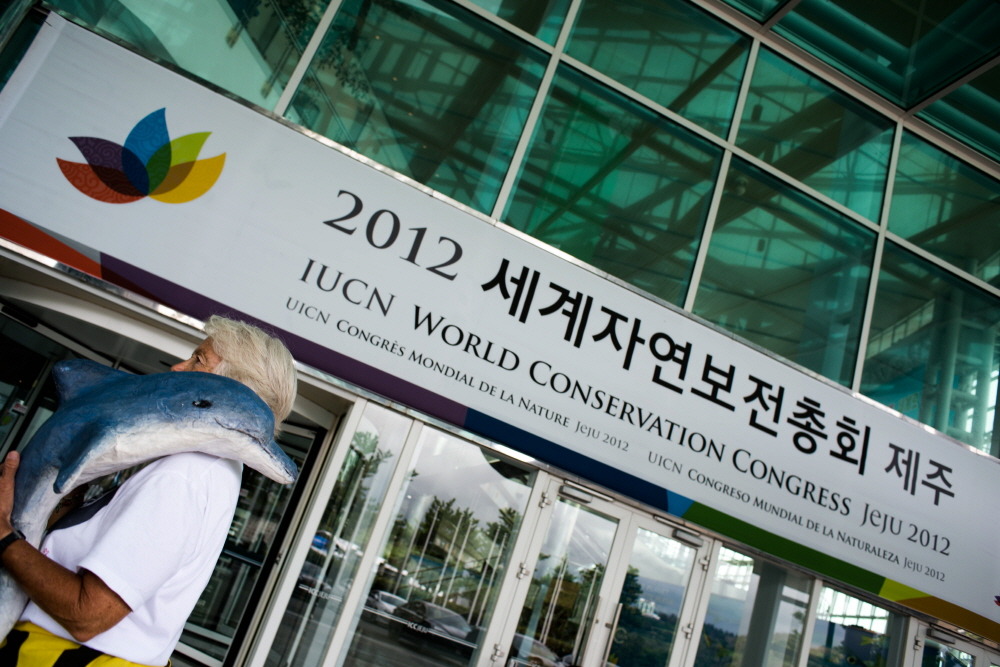
Photo by Jeong Dauri (source)/ An international protester against the Jeju naval base project holds a doll of Indo-Pacific bottle nose dolphin that remain only 100 in Jeju and throughout Korea, in front of the WCC venue, during the 2012 WCC Jeju. For more photos, see the source. 2. Otherwise, the Jeju Island government is driving for the project for the Jeju World Leaders’ Conservation Forum, as a following measure for the Jeju declaration adopted in the 2012 WCC Jeju. The Jeju Island is to poster the forum as the Korean version Davos forum.”
The Jeju-based Halla Ilbo has reported on Jan. 30, 2013, that consultation between the Ministry of Environment and Jeju island government started on the discussion of participation size, program, agenda, budget size, organizing, establishment of foundation, methods of fundraising. Their aim is to hold its 1st forum in April, 2013.
Its strategy is to jointly sponsor the forum by the IUCN, Ministry of Environment, and Jeju island government and presents a new model for an environment meeting that presents a new vision by the discussion by ‘the highest-ranking leaders in the environment field.’
It is ironic and hypocritical that the Jeju Island government who joins the destruction with the naval base project in the Gangjeong village promotes the Jeju as a world environment herb that is centered on the big oligarchies such as Samsung, the main construction company of the Jeju naval base project.
3. The Island government’s such shameful remarks and moves are in line with the government propaganda to attribute to the opponents against the base project as the ‘pro-North Korea left wing.’
It was on March 18, 2013, that a Korean media, Hankyoreh disclosed that Won Se-Hoon, chief of the ROK National Intelligence Service interfered in the Pre-Presidential election by ‘ordering his employees to interfere directly in national politics.’ The results were employee’s black comments in on-line sites to defame the opponents against the Jeju naval base project. The article reads:
‘Several similarities were detected between Won’s messages and messages posted by Kim on the site Today’s Humor. Her messages also contained criticisms of opponents to the building of a naval base on Jeju Island, praise for former President Lee Myung-bak’s overseas tours, and characterizations of opposition politicians as “pro-North Korea.” The similarities support claims that she acted according to the NIS chief’s orders.’
Some groups including the Office of Jang Hana (National Assembly woman, Democratic United Party), Democratic Lawyers’ Association and People’s Solidarity for Participatory Democracy (PSPD) have filed for lawsuits on Won Sei-Hoon for the charge of defamation on March 21.
The inter-connections among the Jeju Island government, navy, police, and National Intelligence Service is nothing new. The 812th program of the ‘PD Note,’ a documentary titled, “Why is the Gangjeong Village, Jeju, So Angry?” broadcast on May 5, 2009 has already disclosed on the secret meeting by those institutes, which shows the Jeju Island government, NIS, navy, and police’s intentional and systematic strategy of division and oppression of the village community for the enforcement of naval base construction. See here.
For the Korean leaders, criticism on Won Sei-Hoon’s policies in relation to the WCC and protesters can be seen here, in detail.
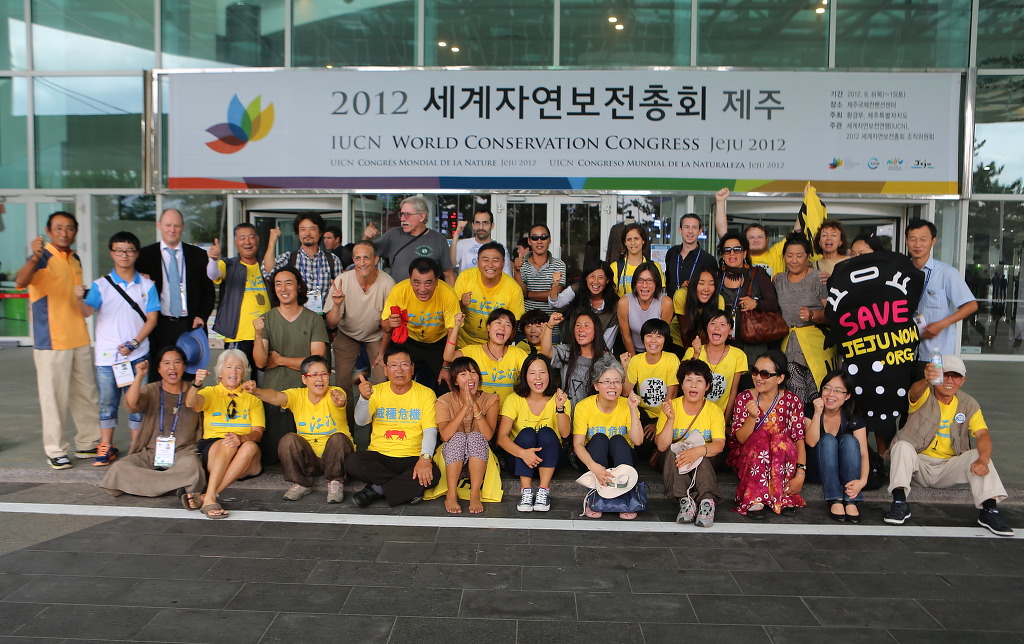
Photo by Cho Sung-Bong (Source)/ Villagers and activists opposing the naval base project on the final day of 2012 WCC Jeju, Sept. 15, 2013. Many NGO people from the world who joined the event have expressed strong support to the struggle. For more photos, see the source.
-
A sacred tree in Gangjeong was designated as a cultural treasure.
A sacred tree in the Gangjeong Village was designated as a Cultural Treasure No. 544. The Cultural Heritage Administration of Korea (CHAK) reported on April 26, 2013.
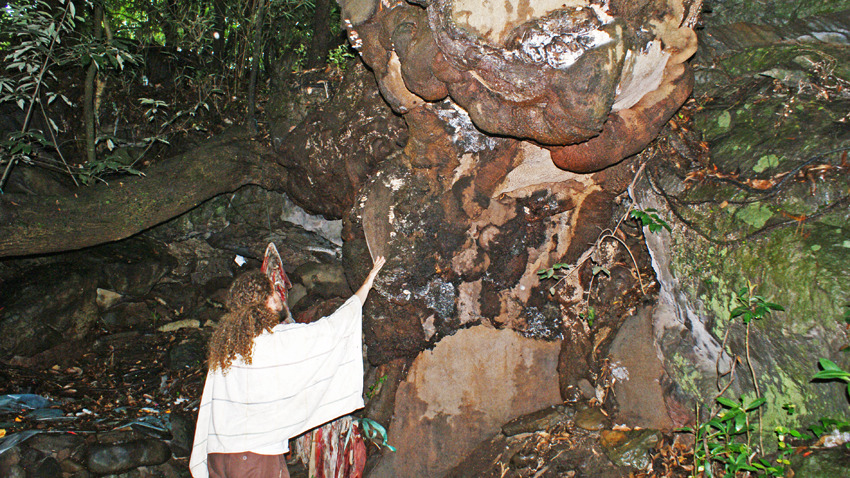
Photo by Cho Sung-Bong, Benjamin Monnet in front of the sacred tree in the Netgiriso shrine, July, 2011. The Headline Jeju, April 26, reports:
‘The evergreen tree, located near the camphor tree habitat (natural treasure No. 162), and belonging to the family of Elaeocarpus sylvestris var. ellipticus is a sacred tree by Jeju folk custom. The villagers have paid their faithful service to it for a long time. Its folk custom and culture value is evaluated high.
The tree’s age is inferred to be about 500 years. Its biological value is high because of its large size with 11.5 m height and very unique shape.
The personnel in the CHAK stated that it “would preserve the tree as natural heritage that the Korean citizens can share together, through the cooperation with the Jeju Special Self-Governing Island.” ‘
The tree is located at the Netgiriso shrine(nicknamed Illuye Grandmother shrine). The word ‘Netgiriso’ means ‘four good omens of fall, rock cliff, sweet fish, and clean water.’ The Netgiriso is the water source of the Gangjeong stream that feeds 70 % of drinking water for about 200,000 citizens of Seogwipo City. It is also a habitat of mandarin duck, natural treasure. The Netgiriso itself is a sacred site where you would not even dare to swim but pay respect and prayer.
Many environment lawyers and activists during the IUCN co-sponsored WCC visited the sacred tree and Netgiriso and expressed their awe to them. See here.

Source: Click here. Many photos of the sacred tree and Netgiriso by Dir. Cho Sung-Bong are available here. Dir Cho took the photos in July 2011. You can see two internationals of Benjamin Monnet and Wang Yu-Hsuan (Emily Wang) there. Both have been forcefully deported by the South Korean government, in March 15, 2012, and April 26, 2013, respectively.
It is told that the navy is planning to build an entry road in the site about 100 m distance from the tree area.

Photo by Save Jeju Now: Kang Mi-Kyung, a meditator of the Seogwipo City leads the prayer in front of the sacred tree in Oct., 2012. The scarf in the back is a present by Ron and Joan Engel, Center for Human and Nature, who visited Gangjeong during the WCC, September, 2012. (source)
-
Destruction of Sea threatening soft coral habitats
It was already reported on April 9 that:
“‘It appeared that the sea area of the Beomseom (Tiger Island) designated as the government natural memorial is largely being threatened as big amount of mud water was leaked from the Jeju naval base construction site into the sea, for the strong rain and wind last weekend.
The Jeju branch of the Korean Federation for Environment Movement stated on April 8, confirming the fact that the damage of mud water reached even to the sea areas of the Beomseom and Seogun Island where soft corals inhibit in group. It would affect their ecology environment not a little. [..]” (See here)
Despite that, the navy has been enforcing construction therefore the Jeju Pan-Island Committee for the Stop of Military Base and for the Realization of Peace Island (Pan-Island committee afterward) made a press conference in the morning of April 12 and demanded stop of naval base construction(destruction) and joint investigation on the affect on the ecology system, as well.
The committee reminded that “The Gangjeong sea, the construction sea area, is a habitat of soft coral designated as natural memorial by the Cultural Heritage Administration of Korea. The focal content of its approval condition on navy base construction is on the installation of silt protectors and thorough operation/management of those for the protection of soft coral habitats.”
“However, not to mention great damage of silt-protectors by recent winds and sea waves, it was confirmed that the status of management and installation of those are quite poor to the degree that those have been of no proper function already from the past.”

Original photo by the Jeju Pan-Island committee/ The canvases of silt-protectors are torn by pieces , functioning nothing for the protection of soft coral habitats(source) 
Photo by the Jeju Pan-Island committee/ Even the gaps between those torn canvases are great. The canvases have no function to prevent dirty water flowing into the soft coral habitats. (Source) 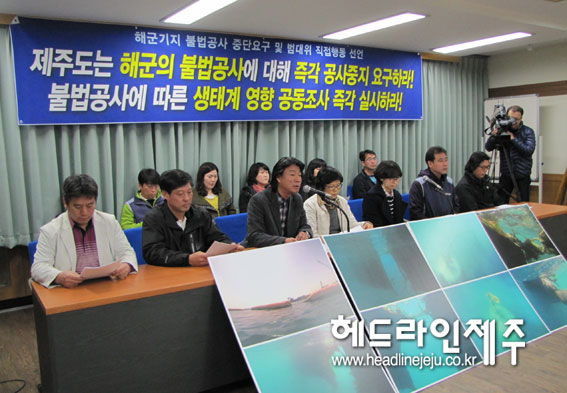
The Pan Island committee’s press conference in the Island People’s Room of the Jeju Provincial Council on April 12. The banner reads, “The Jeju Island government should promptly demand stop on the navy’s illegal construction!
Immediately carry out joint investigation on the ecology affect following illegal construction(destruction)!” (source)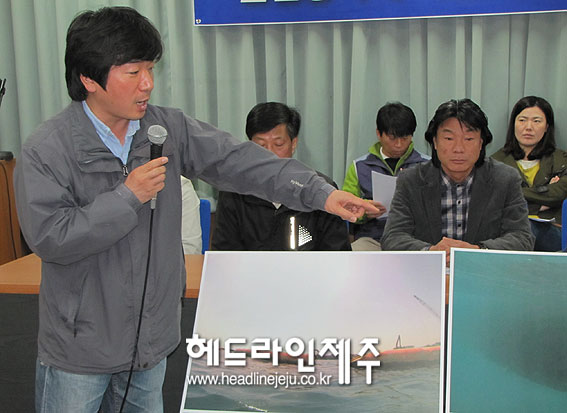
The Jeju Pan-Island committee’s press conference on April 12 (source) Even though it is righteous that there should be protection layers installed to prevent sea weeds onto canvases and should be works to remove those there, various sea weeds have already been propagating on the canvases.
The ropes that have been installed to the bottom of sea water to prevent the move of the canvases were already cut in tremendous amount. No obligatory item on the repair of silt protectors has been kept, not to mention formal floating buoys of silt protectors only on sea surface. (decoration?)
The committee criticized both the CHAK and navy and demanded the Island government to take prompt measures on those problems.
“While it is already problematic that the CHAK approved navy construction only on the condition of installing silt-protectors as a way to protect soft coral habitats where tens of law-protection species inhibit, the navy’s behavior to carry out the condition only with formality is dumbfounding.”
The committee also raised issue on ‘extreme exclusiveness’ of the naval base construction area that is in fact, ‘extraterritoriality zone.”
The navy has intentionally delayed or refused visits even by the government officers who were to confirm the violations of laws inside the construction area.
The committee, criticizing the Island government’s clear dereliction of its duty, demanded it to make a prompt order on the stop of navy’s illegal construction (destruction) and to take strong administrative measures on it.
The committee also emphasized that there should be a joint investigation on the affect on the ecology system and independent post-EIA (Environmental Impact Assessment), joined by Gangjeong villagers and environment groups. It also claimed that there should be joint examination on the items of performance on the approval conditions within the naval base construction area.
It should be noted that people have been demanding such things numerous times, pointing out the problems of illegal construction on the sea (for example, see here). The navy has always ignored people’s demands while the Island government has been irresponsible to take clear and strong measures on the navy.
The Jeju Island government was told to have requested the navy to pose construction until the completion of restoration on the silt-protectors but the construction(destruction) noise in the construction area in the night was louder than ever on the very day (April 12) of its request to the navy.

Photo and caption by Park Inchun on April 11/ ‘Like yesterday, the truck even without a back plate pours rocks unwashed and leaves remaining dusts behind. Cement lumps of heavy metals and chemicals from the Hwasoon port, too… ‘ See more photos by Park Inchun from the Moetppuri, here 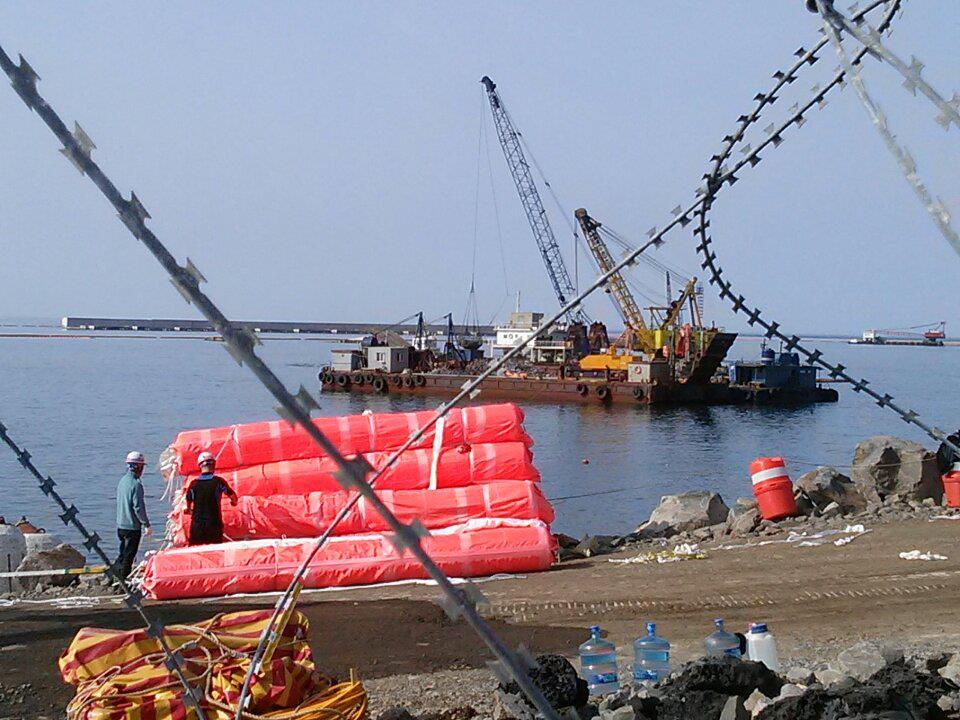
Photo and caption by Park Inchun on April 13/ ‘Even though the Island government made an agreement with the naval base project committee on April 12 that the committee would pose the maritime construction until the repair of silt protectors and investigation on it on Monday, April 15, construction(destruction) has been going on the night of April 12 and next morning of April 13.’ For more photos, see here. 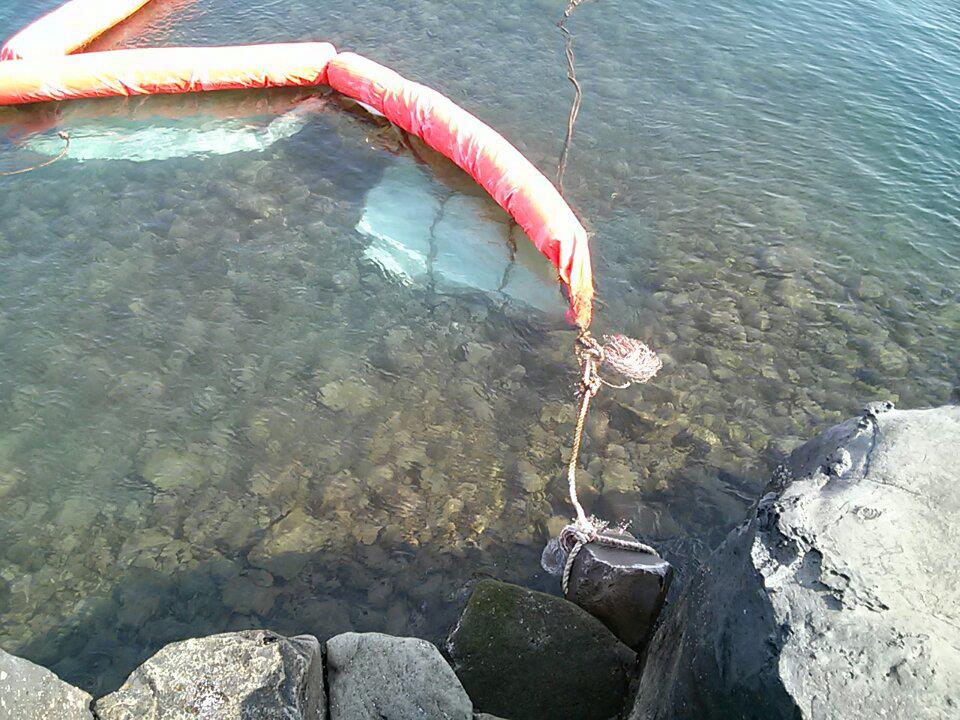
Photo and caption by Park Inchun on April 13/ ‘In the areas of Gangjeong and Ackeun streams, sands are gone and the areas are full of rubbles flown from the construction site. It is told that sweet fishes, hairtails, squids can lay eggs where sands are many.. The navy is fitting water depth to the request by the United States[..]’ For more photos, see here. 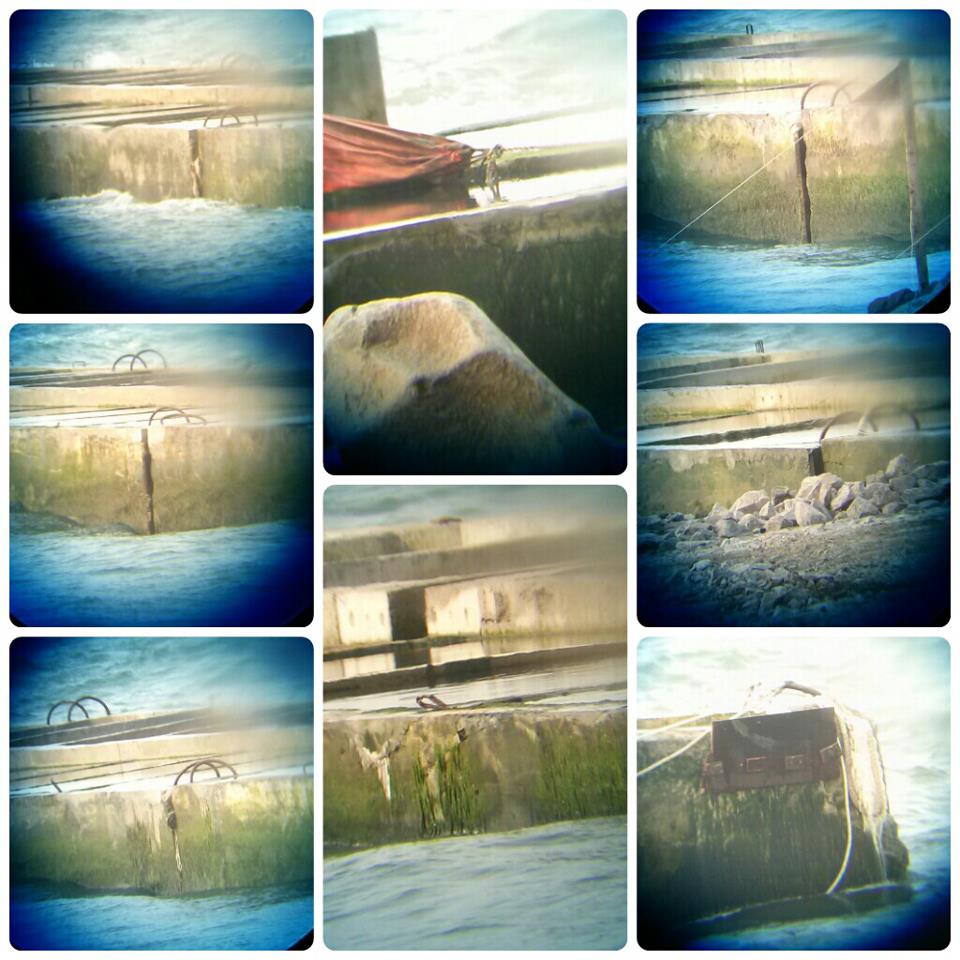
Photo and caption by Park Inchun on April 14/ ‘These are the conditions of caissons seen from the Moetppuri. The caissons are going astray and having differences between themselves. Despite repair on the broken parts, another cracks are occurring beside those..proofs of unreliable construction.. It has been only for short time since the repair.’ (source) 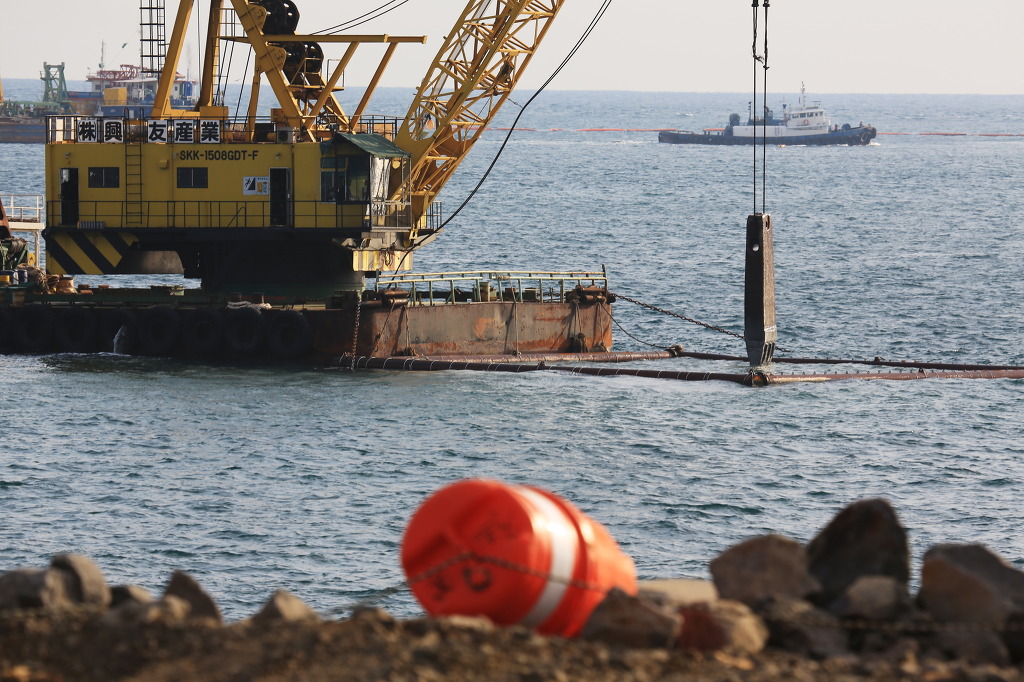
Photo and caption by Cho Sung-Bong/ a tough excavator that breaks rocks underwater. For more photos, see here. 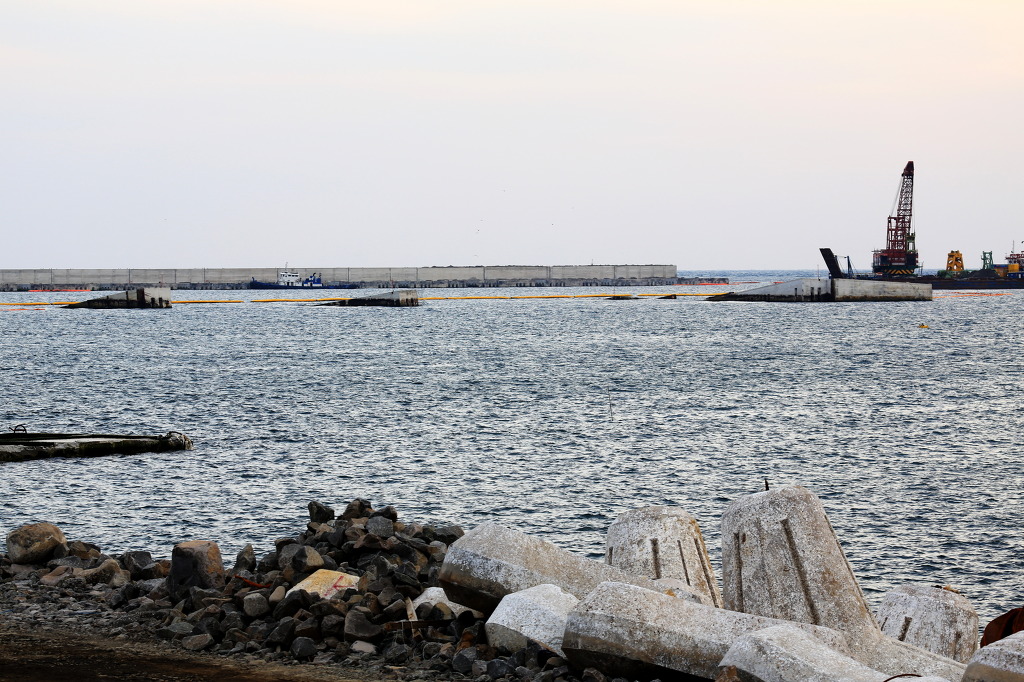
Photo and caption by Cho Sung-Bong on April 14/ The Hankook Ilbo, April 8, 2013, reports.. ‘The work rate in the 1st and 2nd work area in the harbor and bay construction has been 39.3 % and 29.9% respectively [* according to the navy that usually exaggerates]. The construction on land could not even start. The military is concerning about, if the current condition that even construction vehicles cannot properly pass by without the presence of police, the construction on breakwater could be delayed and imminent preparation for typhoon this summer could be difficult.” For more photos, see here. 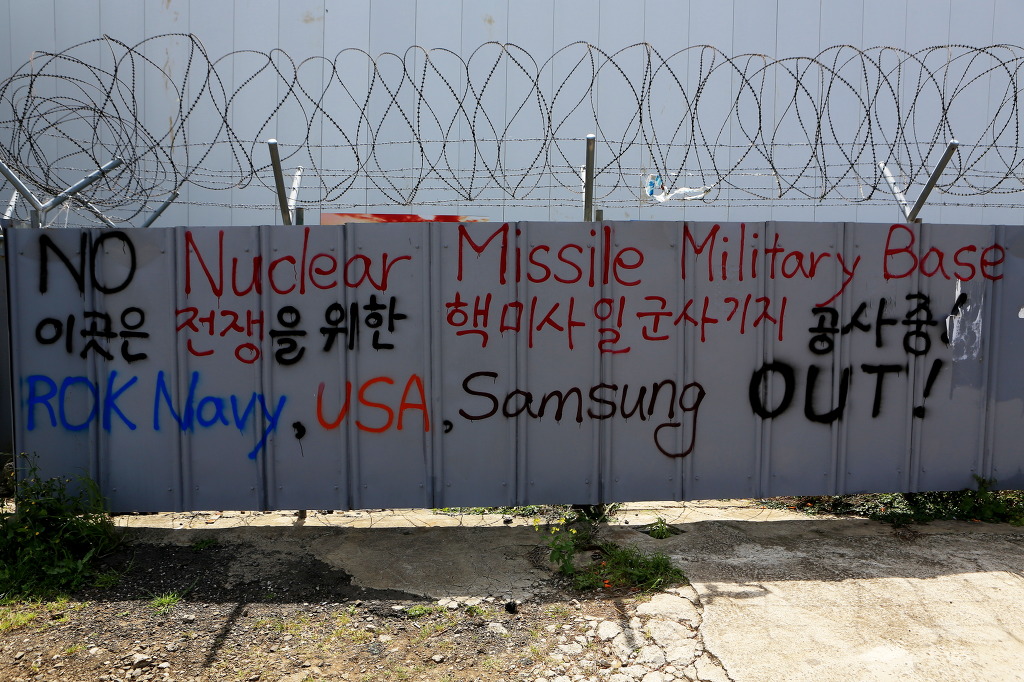
Photo by Cho Sung-Bong. Source 
Photo by Cho Sung-Bong/ Weather vanes put by an activist on the way to the Moetppuri. Source





